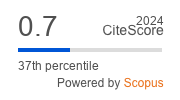Bacterial Infections Associated with Cutaneous Leishmaniasis
Keywords:
Bacteria and Leishmania, Bacterial skin infection,, , L concomitant infectionsAbstract
Background:Oriental sore occurs mostly in the
mediteranian region , North Africa ,and the Middle East .
Rodents are the main reservoir for the parasite . The wet
type caused by L. major is rural and the dry type caused by
L. tropica is urban and humans are presumably the only
reservoir. Sand fly vectors are involved in all forms.
Objectives: This study aimed to show the most
important bacterial infections concomitant with cutaneous
leishmaniasis .
Methods; The study was performed on 75 patients (ages
1-50 years ) from both sexes were attending Skin Diseases
Department of Ramadi General Hospital during the period
extended from January to June 2000. These patients were
clinically diagnosed as patients with cutaneous
leishmaniasis. Skin specimens were taken for
bacteriological and parasitological investigations .The same
thing was done for specimens from 25 intact individuals
resembling the test group as negative controls.
Results: Children showed more lesions with Positive
cutaneous leishmaniasis, adult females, showed more l
lesions than adult males. Children showed more bacterial
isolates than adults, from both positive and negative l
lesions. Staphylococcal and Streptococcal isolates took the
first rank of isolation in all age groups and both sexes. E.
coli and fecal Streptococci were isolated from children
only.
Conclusion: Bacterial invasion for the skin lesion with
cutaneous leishmaniasis complicates the lesion and leads to
misdiagnosis, in addition to the delay of healing of the
lesion via bacterial end-products. There is a need for
accurate diagnostic techniques like polymerase chain
reaction (PCR) for both bacterial and parasitic agents,
suitable effective antimicrobial therapy, in addition to the
antileishmanial agents. Good sanitation of the lesion and
community education to prevent infections













